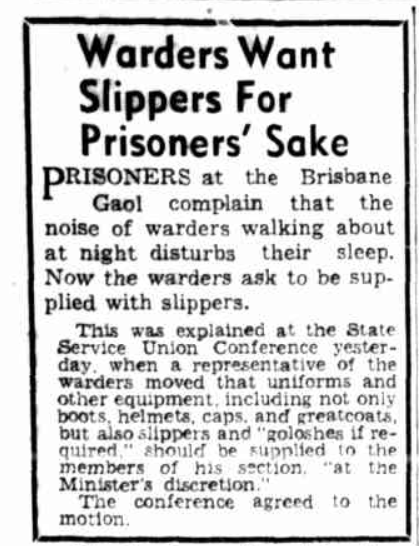Officer’s requests
- On : 15 June, 2018
- By : Boggo Road Gaol
- Category : Stories
- View : 2133
Officer’s requests
Some would say that Prison Officers have one of the toughest jobs in the world. Everyday they enter the world behind bars and work with some of the worst of the worst. Ever wonder what it takes to do the job? Well in this week’s article we talk about the prison service and the role that officers had in shaping the correctional institutions in Queensland as we know them today.
Officer’s requests
Some would say that Prison Officers have one of the toughest jobs in the world. Every day they enter the world behind bars and work with some of the worst of the worst. Ever wonder what it takes to do the job? Well in this week’s article we talk about the prison service and the role that officers had in shaping the correctional institutions in Queensland as we know them today.
Prison Service in Queensland
The prison service in Queensland is one of the foundation departments formed when Queensland was separated from New South Wales in 1859. Officially forming in 1860 the service was represented by various small gaols, penal establishments and lock ups in the colony. These were all under the management of the Sheriff of Queensland. Sounds a bit like the wild west doesn’t it? In 1887 a commission into the management of the various gaols, penal establishments and lockups in Queensland brought about a sweeping change. The report recommended the consolidation and amendment of legislation to make room for the creation of the Prison Service and the appointment of the Controller General to manage all prisons in the colony.
These changes would not happen quickly, it takes quite some time to make significant changes to legislation. The Prisons Act of 1890 would be the eventual result. The act will be the first of many changes over the coming decades.
The changes in the management of prisons in Queensland would mean the hiring and retraining of staff. These continual changes in expectations over the life of HM Prison Brisbane later known as Brisbane Correctional Centre or Boggo Road Gaol were posted on the wall for officers to see and apply as they happened. A copy of the vast majority of these are kept in a fascinating series of records held at the Queensland State Archives. These records were held in each of the prisons in Queensland.
Prison Rules and Orders Book: 1869-1961 – Brisbane Correctional Centre.
Description:
Books of letters, circulars and memoranda from the Sherriff of Queensland and later the Controller General of Prisons to the Superintendent of the Brisbane Gaol later known as HM Prison Brisbane or the Brisbane Correctional Centre.
So, what happened if you didn’t follow the rules? Well, you would be officially charged, and the details recorded in an equally fascinating series the Register of officials and warders and defaulters book 1865-1947. The punishment being anything from being docked a day’s pay, to dismissal and even a prison sentence!
Prison and Asylum Workers Union
Just like any other union, it is set out for the purposes of protecting the rights of workers. Founded in 1915, it was the beginning of the union movement in the prisons and asylums in Queensland. In August of 1915 the inaugural conference was held in Trades Hall, Brisbane. The first conference set out the rules and regulations of the union and elected a committee. In attendance were representatives from all the gaols, penal institutions, lockups and asylums in Queensland. It certainly must have been an impressive turn out.
As an outcome of the conference, the subsequent report set some of the foundations of the modern system of employment in the correctional services industry. Indeed, you will probably recognise some items that are still in practice today and some that are still under negotiation in most industries a century later.
- A 40-hour week
- Salary increases
- Night shift allowance
- Overtime
- Vacancies posted in the Government Gazette
- Equal pay for male and female employees
- No extra duties for night staff
- Charges made in writing – what we later know as a written warning.
The conference committee then approach the Sherriff or later the Controller General for approval of the items discussed. The conferences held under the Prison and Asylum Workers Union continued until 1918, when the two were separated. These unions are now covered under the Australian Workers Union.
 Sublime to the ridiculous?
Sublime to the ridiculous?
An article published in the Courier Mail Newspaper in August of 1939 dealt with the need for prison officers to have slippers… so as to not wake the prisoners at night! Of course, at the minister’s discretion! Whether or not this ever came in, is not yet known. But we will keep you posted!
Want to know what it was like to be an officer at Boggo Road Gaol? Come along this Sunday for our officer tour and meet former officer Kevin Hayden! For more information click here
This article was contributed by Research Coordinator Sue Olsen as part of the ongoing research program for Boggo Road Gaol Pty Ltd. The aim of the program is to bring to light and share articles relating to Boggo Road for the purposes of review and study. Do you have a story to share or something you would like us to know about? You can contact the research team here.


